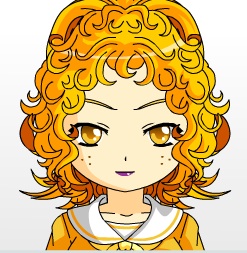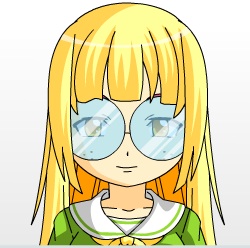
An interview with Annalinde Matichei
SDP: One question that arises in the minds of many readers of Goldenhead: Why did you write a text novel with anime characters?
AM: They aren’t exactly anime characters, though some of them do look very much like that.
The point is that something akin to anime is the “visual language” of their manifestation on certain levels of being.
All things are spiritual first, before they become manifested. They look the way they do because of their spiritual forms. Modern humans look the way they do from a whole complexity of reasons. Their basic human shape is a fundamental expression of their nature, but a lot of the way they look now—in this world-era, the Kali Yuga—is because they are manifested in a highly “consolidated” or material age.
SDP: So you don’t think materialism is just something that happens in the human mind—it is part of the world at the present time?
Materialism is a human phenomenon, but materiality, particularly the high degree of materiality that characterizes your world today, is a fact of your environment, which is very consolidated. That is why you don’t currently have dragons or unicorns and can’t find their remains on your current physical plane; and why your faeries are so hard for you to see.
SDP: And you think the anime style sees beyond this consolidation?
I think visual languages are very important and they are not just creations of the human mind. At least certain important ones aren’t. They can show us aspects of reality that are veiled from a particular time and place. I believe Disney did a huge service to the Western world and the world as a whole in opening up a new vision of the innocence and beauty that the world had lost. Japanese anime artists have built on the Disney vision. I am not saying this or that anime is “true”. I am saying that the style as a whole represents a kind of truth, and that it is a visual language that works for good in this world-era.
 SDP: A lot of people think these styles are cutesy and saccharine.
SDP: A lot of people think these styles are cutesy and saccharine.
Cutesy and saccharine are cynical people’s terms for “good”. The whole point about “cuteness” is that it appeals to the pure childlike goodness that is in us. That is why a lot of people don’t like it!
And that fundamental goodness isn’t just in us. It is in the cosmos itself.
SDP: So you think the universe is essentially good?
I think the deepest and most fundamental things are good. But there is also evil in the universe. Manifestation brings about a battle between good and evil. That is what Goldenhead and everything else I write is about. It is about fundamental good and purity and innocence, and its struggle against the dark and demonic forces that would destroy all goodness if they could.
SDP: But aren’t we all a mixture of good and bad?
Yes indeed. Every person is a microcosmos—a little world—so the war between good and evil takes place inside each of us as well as in the greater cosmos. But I do think your current patriarchal world has more of its evil internalized. Most of the societies in these books are fundamentally good. People make mistakes; people have weaknesses; people do bad things. But fundamentally the society and most individuals are agreed on what is good and are devoted to it.
So their wars are not against each other—they are against demons: because the principle of evil is not manifested primarily through themselves. You see the difference? In your world, your wars for a very long time (not always, but for a very long time) have been against other humans. In a typical war, each side thinks it is the Side of Good and the other side is the Side of Evil. The German soldiers had “Gott mit uns” (God with Us) on their belt buckles. And that is what every side believes, whether it puts it on its buckles or not.
And in a way, they are right, they are fighting a sort of proxy war with the “devil” that is incarnated in the other side. And the other side is doing the same thing.
We don’t do that. We don’t kill our own kind. We believe fundamentally in the goodness and purity and innocence that so many humans sneer at. We do have wars, since conflict is in the nature of manifest existence, but we fight the forces of darkness directly, rather than seeing them in each other. So all our wars have been demon-wars.
In fact it is not really accurate to call them “wars” like your wars—the war over this, the war over that—they are all the one war, the Vikhail: the eternal struggle between good and evil, light and darkness. The combat that protects the goodness of our worlds and keeps the light of innocence burning pure.
 So the anime style is expressing this fundamental goodness?
So the anime style is expressing this fundamental goodness?
Partly, but it is not simply “symbolic” (except as far as everything in existence is fundamentally symbolic). It is also a function of the level of reality on which the Little Knights are operating. They are not in physical bodies, and they operate in a variety of environments. The Imperial Princess may not be physical at all, although it follows very physical and apparently technical “rules of being”. Shaillemere is in a world that is much less consolidated than the ones we are used to—a world where many technical things don’t work, but magic does. Nevrayapurh is in a much more material and technical “modern” world—but it is still probably less “consolidated” than earth.
The anime-style bodies of the Little Knights work differently in different places. In Nevrayapurh, most people can’t see them, for example. In Shaillemere, everyone can. Their “visual language” is not just symbolic: it is a condition of their particular level of manifestation.
SDP: On another note: there has been some discussion about whether Goldenhead is the sequel to The Flight of the Silver Vixen. Is it?
AM: No. I am actually working on Vixen II (working title) right now. Goldenhead is a very different type of book. It is set in the same universe, but most of the time, you’d hardly know it! There is one character from Vixen who appears in Goldenhead, and if you look at the chronology, you can see that the whole action of Vixen takes place over a couple of days and Goldenhead actually takes place over the following few days. They are parts of the same overall story, but very different parts.
SDP: Thank you for your time and for the honor of this interview.
Thank you – the honor was all mine.






